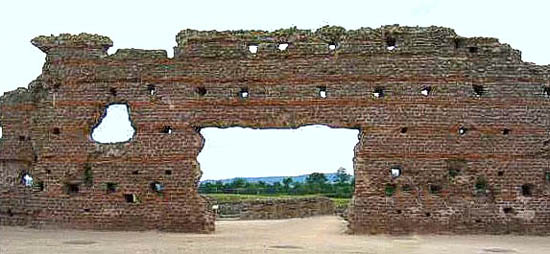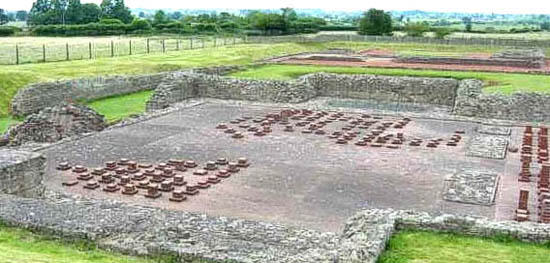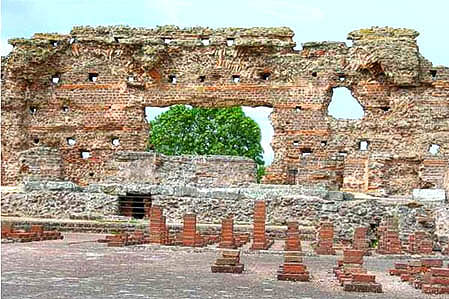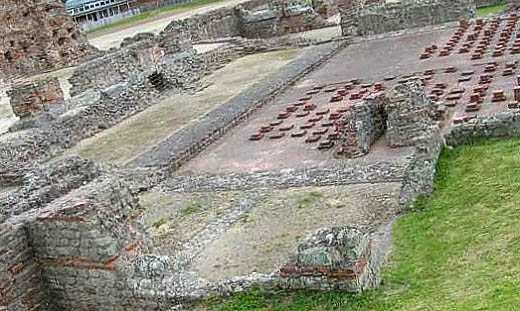Wroxeter - Roman Britain's Fourth Largest City
by Dr. Gareth Evans
Nestling halfway between the mediaeval town of Shrewsbury and the birthplace of the industrial revolution at Ironbridge, lies Viroconium -- once the fourth largest city in Roman Britain. While its three greater fellows -- London, Cirencester and St. Albans -- have all undergone considerable further development in subsequent ages to yield an amalgam of historical overlays, Viroconium was simply abandoned sometime in the 5th or 6th Century.

In its heyday, Viroconium (also called Uriconium and now often known as Wroxeter -- the name of the small village adjacent to the site) was home to more than 6,000 inhabitants and has been described as one of the best examples of 2nd Century town planning. With the majority of its 200-acre site still awaiting excavation, Viroconium already boasts one of the largest surviving sections of Roman wall in Britain together with extensive remains of the city's baths and hypocaust, making it a uniquely important site in Britain.
Early History
The settlement is entirely of Roman origin, probably beginning as a temporary marching camp established beside the great arterial route of Watling Street around AD 48 and would then have stood on the edge of the Roman Empire, forming part of its frontier with Wales. The discovery, in 1975, of a fortress on the site sheds some light on the likely next phase of the city's development. In AD 58, some ten years after the site had first been settled, the Emperor Nero decided to secure the Imperial boundary by subjugating the adjoining Welsh lands. This was to see the military presence in this key outpost change from a temporary camp-site to a permanent garrison. It is believed that the XIV Legion were the first occupants of this new encampment and were subsequently replaced by the XX Legion from AD 69 - AD 80.

The Hypocaust
The next major stage came once the settlement's role changed from that of a front-line base. With the scaling down of the military presence, the growing town would have passed to the civil authorities and become one of the Coloniae -- a community for Roman Citizens, principally retired servicemen, created to show the benefits of civilization to the native tribes. By this time, Viroconium had already established a sizeable civilian population, largely drawn by the relative safety of the fort and the economic opportunities offered by supplying the needs of the troops stationed there. Declared the capital of the Cornovii Britons and given both its own administration and good measure of local autonomy, the city's development subsequently grew along the typical grid-line pattern characteristic of such tribal centres. The law court, market place and public baths date from this period.
The City's Heyday
The last and greatest phase of expansion began early in the 2nd Century and was to continue for much of the next 80 years. While the Emperor Hadrian is most readily associated with the construction of the famous northern wall which bears his name, it was during this same period that Viroconium was enlarged further to become a truly significant city.
This saw the construction of a new civic centre, together with a basilica and bath house, part of which remains today as the "Old Work" -- one of Britain's largest sections of freestanding Roman masonry still in existence. By the end of the 2nd century, and with the construction of many more houses, colonnades and other fine buildings, Viroconium had grown to become Roman Britain's fourth largest city. Today, it is difficult to imagine the scale of this, with only a very small part of the ancient site exposed to view, but then the newly constructed ditch and ramparts which enclosed the city extended for over two miles.
End of Empire
The fortunes of Viroconium, however, were set to change as the events of the 3rd and 4th Centuries played out in a period marked by contrasting turbulence and prosperity. The influx of goods from the rest of the Roman Empire, coupled with the open extension of citizenship had given Britain a very different character from the newly-conquered province which had originally given rise to the settlement. The 4th Century in particular was to be a period of unrivalled prosperity, with many moneyed settlers moving to Britain from less secure parts of the Empire, such as the Rhineland and Gaul. Although none of the numerous accounts offered for this unparalleled upsurge in the Roman-British economy really explains the phenomenon completely, the "Golden Age of the Villa" was a real enough event, particularly in the opulent buildings of southern England.
However, the late 3rd Century was also a period of mounting unrest within the Roman Empire as inflation soared, civic regulation grew and bureaucratic interference became widespread. In addition, although Britain herself was largely unaffected, many regions suffered repeated incursions from barbarian tribes. For Viroconium, the growing political turbulence throughout the 3rd and 4th Centuries, coupled with spiralling maintenance costs gradually led to many of the once great buildings in the city lying unused and ultimately becoming derelict. Some were subsequently dismantled, while others fell into increasingly poor repair.

The Bathhouse
By about AD 408, when the last of the Legions was withdrawn, a now defenceless Britain effectively ceased to be a part of the Roman Empire and was left to face the Saxon threat alone -- as the letters written by Emperor Honorius in AD 410 to the British cities made clear.
At this point, the fortunes of Viroconium changed again. The basilica and bath house had been used as a grain store, but in the early 5th Century the basilica was tidied up, and a substantial new hall together with a number of barns and other buildings constructed within the old Roman city. It is not known who instigated this work, nor why, but given the time period and the close proximity of the site to Wales, it has been suggested -- with some supporting evidence -- that this site might have formed King Arthur's main base during his campaigns. Whether Viroconium really was the Camelot of legend or whether some other local prince or king carved a domain for himself amid the remnants of the old capital of the civitas Cornoviorum* will perhaps never be known. (In Roman Britain, most of the country was divided into Civitates -- largely self-governing areas based around the pre-conquest tribal lands. The hub of the administration and local government of each civitas was a tribal centre or civitas capital.) Whoever and whatever its most recent occupant may have been, the city is believed to have been finally vacated sometime between AD 500 -- AD 650.
The Site Today
The site comprises a range of extensive archaeological remains, including the public baths with their imposing 2nd Century dividing wall, together with a visitor centre, shop and museum which houses a good selection of artefacts and interpretive displays.

The Baths
The baths themselves, which could accommodate over 1,000 users, were first cleared in 1859 and subsequently excavated between 1955 and 1985. Many of the original features can be seen, such as the stone doorway into the warm room, the remains of the furnace that once heated the dry room and the twin rows of columns making up the central colonnade which ran between the different sections of the building.
Excavation of the basilica, of which the "Old Work" formed part of the south wall, was begun in 1966, ending in 1990, by which time a well-worn sandstone floor had been revealed at the west portico entrance, together with a collapsed mosaic and the damaged floor of the cold room. The site also boasts a large hall, which was believed to have been used for sporting or social activities and the remains of the hypocaust heating system.
Viroconium is one of the best, and sadly most often overlooked, of Britain's Roman heritage sites and certainly a worthwhile venue on any itinerary around this part of the English borders.
Location
Viroconium is in Shropshire, where the English Midlands border Wales. It located beside the B4380, about five miles to the south east of Shrewsbury, the county town. The site is well signposted.
More Information:
We regret that we no longer have the resources to maintain up-to-date links and/or hours and pricing details for the various sites and attractions listed on this website. For more information about the location(s) listed above, please use your favorite search engine or visit Wikipedia.
Gareth Evans is a freelance writer and photographer, having previously worked in the private sector before lecturing at the University of Durham. Having travelled extensively, he now concentrates on writing about subjects much closer to home -- both geographically and metaphorically. He is particularly interested in myths, legends and folklore, together with the often forgotten history of the Celtic lands, especially that of his own native Wales and Scotland, his adopted home. Gareth is currently planning his next book, looking at the role of the pagan Horned God in myth and history.
Article and photos © 2005 Gareth Evans
|
